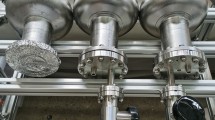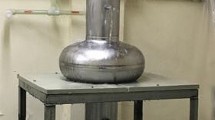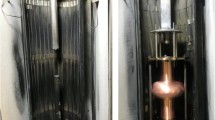Abstract
Two 650 MHz single-cell superconducting radio-frequency (SRF) cavities used for the Circular Electron Positron Collider (CEPC) were studied to achieve a high accelerating gradient (Eacc) and high intrinsic quality factor (Q0). The 650 MHz single-cell cavities were subjected to a combination of buffered chemical polishing (BCP) and electropolishing (EP), and their Eacc exceeded 40 MV/m. Such a high Eacc may result from the cold EP with more uniform removal. BCP is easy, cheap, and rough, whereas EP is complicated, expensive, and precise. Therefore, the combination of BCP and EP investigated in this study is suitable for surface treatments of mass SRF cavities. Medium temperature (mid-T) furnace baking was also conducted, which demonstrated an ultrahigh Q0 of 8 × 1010 at 22 MV/m for both cavities, and an extremely low BCS resistance (RBCS) of ~ 1.0 nΩ was achieved at 2.0 K.









Similar content being viewed by others
References
H. Padamsee, 50 years of success for SRF accelerators—a review. Supercond. Sci. Technol. 30, 053003 (2017). https://doi.org/10.1088/1361-6668/aa6376
P. Sha, J.K. Hao, W.M. Pan et al., Nitrogen do**/infusion of 650 MHz cavities for CEPC. Nucl. Sci. Tech. 32, 45 (2021). https://doi.org/10.1007/s41365-021-00881-3
T. Dohmae, K. Umemori, M. Yamanaka et al., Investigation of in-house superconducting radio-frequency 9-cell cavity made of large grain niobium at KEK. Nucl. Instrum. Methods Phys. Res. A 875, 1–9 (2017). https://doi.org/10.1016/j.nima.2017.08.050
X.Y. Pu, H.T. Hou, Y. Wang et al., Frequency sensitivity of the passive third harmonic superconducting cavity for SSRF. Nucl. Sci. Tech. 31, 31 (2020). https://doi.org/10.1007/s41365-020-0732-x
D. Reschke, V. Gubarev, J. Schaffran et al., Performance in the vertical test of the 832 nine-cell 1.3 GHz cavities for the European X-ray Free Electron Laser. Phys. Rev. Accel. Beams 20, 042004 (2017). https://doi.org/10.1103/PhysRevAccelBeams.20.042004
Y.X. Zhang, J.F. Chen, D. Wang, RF design optimization for the SHINE 3.9 GHz cavity. Nucl. Sci. Tech. 31, 73 (2020). https://doi.org/10.1007/s41365-020-00772-z
D. Gonnella, S. Aderhold, A. Burrill et al., Industrialization of the nitrogen-do** preparation for SRF cavities for LCLS-II. Nucl. Instrum. Methods Phys. Res. A 883, 143–150 (2018). https://doi.org/10.1016/j.nima.2017.11.047
R. Garoby, A. Vergara, H. Danared et al., The European spallation source design. Phys. Scr. 93, 014001 (2018). https://doi.org/10.1088/1402-4896/aa9bff
K. McGee, S. Kim, K. Elliott et al., Medium-velocity superconducting cavity for high accelerating gradient continuous-wave hadron linear accelerators. Phys. Rev. Accel. Beams 24, 112003 (2016). https://doi.org/10.1103/PhysRevAccelBeams.24.112003
S.-H. Kim, R. Afanador, D. Barnhart et al., Overview of ten-year operation of the superconducting linear accelerator at the spallation neutron source. Nucl. Instrum. Methods Phys. Res. A 852, 20–32 (2017). https://doi.org/10.1016/j.nima.2017.02.009
F. Yan, H.P. Geng, C. Meng et al., Commissioning experiences with the spoke-based CW superconducting proton linac. Nucl. Sci. Tech. 32, 105 (2021). https://doi.org/10.1007/s41365-021-00950-7
M. Martinello, D. Bice, C. Boffo et al., Q-factor optimization for high-beta 650 MHz cavities for PIP-II. J. Appl. Phys. 130, 174501 (2021). https://doi.org/10.1063/5.0068531
K. Saito, H. Inoue, E. Kako et al., Superiority of electropolishing over chemical polishing on high gradients. in Proceedings of the 1997 Workshop on RF Superconductivity, Abano Terme, Padova, Italy (1997), pp. 795–813
L. Lilje, D. Reschke, K. Twarowski et al., Electropolishing and in-situ baking of 1.3 GHz niobium cavities, in Proceedings of the 1999 Workshop on RF Superconductivity, La Fonda Hotel, Santa Fe, New Mexico, USA (1999), pp. 74–76
A. Grassellino, A. Romanenko, D. Sergatskov et al., Nitrogen and argon do** of niobium for superconducting radio frequency cavities: a pathway to highly efficient accelerating structures. Supercond. Sci. Technol. 26, 102001 (2013). https://doi.org/10.1088/0953-2048/26/10/102001
S. Posen, A. Romanenko, A. Grassellino et al., Ultralow surface resistance via vacuum heat treatment of superconducting radio-frequency cavities. Phys. Rev. Applied 13, 014024 (2020). https://doi.org/10.1103/PhysRevApplied.13.014024
H. Ito, H. Araki, K. Takahashi et al., Influence of furnace baking on Q-E behavior of superconducting accelerating cavities. Prog. Theor. Exp. Phys. 2021, 071G01 (2021). https://doi.org/10.1093/ptep/ptab056
R.L. Geng, G.V. Eremeev, H. Padamsee et al., High gradient studies for ILC with single-cell re-entrant shape and elliptical shape cavities made of fine-grain and large-grain niobium, in Proceedings of PAC07, Albuquerque, New Mexico, USA (2007), pp. 2337–2339
T. Kubo, Y. Ajima, H. Inoue et al., In-house production of a large-grain single-cell cavity at cavity fabrication facility and results of performance tests, in Proceedings of IPAC2014, Dresden, Germany (2014), pp. 2519–2521
S. Posen, A. Cravatta, M. Checchin et al., High gradient performance and quench behavior of a verification cryomodule for a high energy continuous wave linear accelerator. Phys. Rev. Accel. Beams 25, 042001 (2022). https://doi.org/10.1103/PhysRevAccelBeams.25.042001
F.S. He, W.M. Pan, P. Sha et al., Medium-temperature furnace baking of 1.3 GHz 9-cell superconducting cavities at IHEP. Supercond. Sci. Technol. 34, 095005 (2021). https://doi.org/10.1088/1361-6668/ac1657
The CEPC Study Group, CEPC conceptual design report: volume 1—accelerator (2018). ar**v:1809.00285
J. Zhai, D. Gong, H. Zheng et al., Design of CEPC superconducting RF system. Int. J. Mod. Phys. A 34, 1940006 (2019). https://doi.org/10.1142/S0217751X19400062
S. **, P. Sha, W. Pan et al., Development and vertical tests of CEPC 650 MHz single-cell cavities with high gradient. Materials 14, 7654 (2021). https://doi.org/10.3390/ma14247654
T. Huang, W. Pan, G. Wang et al., The development of the 499.8 MHz superconducting cavity system for BEPCII. Nucl. Instrum. Methods Phys. Res. A 1013, 165649 (2021). https://doi.org/10.1016/j.nima.2021.165649
Y. Huang, L. Liu, T. Jiang et al., 650 MHz elliptical superconducting RF cavities for CiADS project. Nucl. Instrum. Methods Phys. Res. A 988, 164906 (2021). https://doi.org/10.1016/j.nima.2020.164906
F. Schlander, C. Darve, N. Elias et al., The superconducting accelerator for the ESS project, in Proceedings of the SRF2017, Lanzhou, China (2017), pp. 24–28
J. Knobloch, R.L. Geng, M. Liepe et al., High-field Q slope in superconducting cavities due to magnetic field enhancement at grain boundaries, in Proceedings of the 1999 Workshop on RF Superconductivity, La Fonda Hotel, Santa Fe, New Mexico, USA (1999), pp. 77–91
T. Kubo, Magnetic field enhancement at a pit on the surface of a superconducting accelerating cavity. Prog. Theor. Exp. Phys. 2015, 07G301 (2015). https://doi.org/10.1093/ptep/ptv088
C. Xu, C.E. Reece, M.J. Kelley, Simulation of nonlinear superconducting rf losses derived from characteristic topography of etched and electropolished niobium surfaces. Phys. Rev. Accel. Beams 19, 033501 (2016). https://doi.org/10.1103/PhysRevAccelBeams.19.033501
A. Romanenko, A. Grassellino, A.C. Crawford et al., Ultra-high quality factors in superconducting niobium cavities in ambient magnetic fields up to 190 mG. Appl. Phys. Lett. 105, 234103 (2014). https://doi.org/10.1063/1.4903808
S. Huang, T. Kubo, R.L. Geng, Dependence of trapped-flux-induced surface resistance of a large-grain Nb superconducting radio-frequency cavity on spatial temperature gradient during cooldown through Tc. Phys. Rev. Accel. Beams 19, 082001 (2016). https://doi.org/10.1103/PhysRevAccelBeams.19.082001
H. Padamsee, RF superconductivity: science, technology and applications (WILEY-VCH Verlag GmbH & Co. KGaA, Weinheim, 2009). (ISBN 978-3-527-40572-5)
T. Kubo, A. Gurevich, Field-dependent nonlinear surface resistance and its optimization by surface nanostructuring in superconductors. Phys. Rev. B 100, 064522 (2019). https://doi.org/10.1103/PhysRevB.100.064522
A. Gurevich, T. Kubo, J.A. Sauls, Challenges and opportunities of SRF theory for next generation particle accelerators. ar**v:2203.08315
M. Martinello, M. Checchin, A. Romanenko et al., Field-enhanced superconductivity in high-frequency niobium accelerating cavities. Phys. Rev. Lett. 121, 224801 (2018). https://doi.org/10.1103/PhysRevLett.121.224801
F. Furuta, D.J. Bice, A.C. Crawford et al., Fermilab EP facility improvement, in Proceedings of SRF’19, Dresden, Germany (2019). https://accelconf.web.cern.ch/srf2019/papers/tup022.pdf
M. Checchin, LCLS-II investigation of failed LCLS-II HE prototype cavities EP analysis, TTC 2020 (Switzerland, Geneva, 2020)
Author information
Authors and Affiliations
Contributions
All authors contributed to the study conception and design. Material preparation, data collection, and analysis were performed by Peng Sha, Wei-Min Pan, and Song **. The first draft of the manuscript was written by Peng Sha, and all authors commented on previous versions of the manuscript. All authors read and approved the final manuscript.
Corresponding authors
Additional information
This work was supported by the Strategic Priority Research Program of the Chinese Academy of Sciences (No. XDB25000000), the National Natural Science Foundation of China (No. 12075270), and the Platform of Advanced Photon Source Technology R&D.
Rights and permissions
Springer Nature or its licensor holds exclusive rights to this article under a publishing agreement with the author(s) or other rightsholder(s); author self-archiving of the accepted manuscript version of this article is solely governed by the terms of such publishing agreement and applicable law.
About this article
Cite this article
Sha, P., Pan, WM., **, S. et al. Ultrahigh accelerating gradient and quality factor of CEPC 650 MHz superconducting radio-frequency cavity. NUCL SCI TECH 33, 125 (2022). https://doi.org/10.1007/s41365-022-01109-8
Received:
Revised:
Accepted:
Published:
DOI: https://doi.org/10.1007/s41365-022-01109-8




